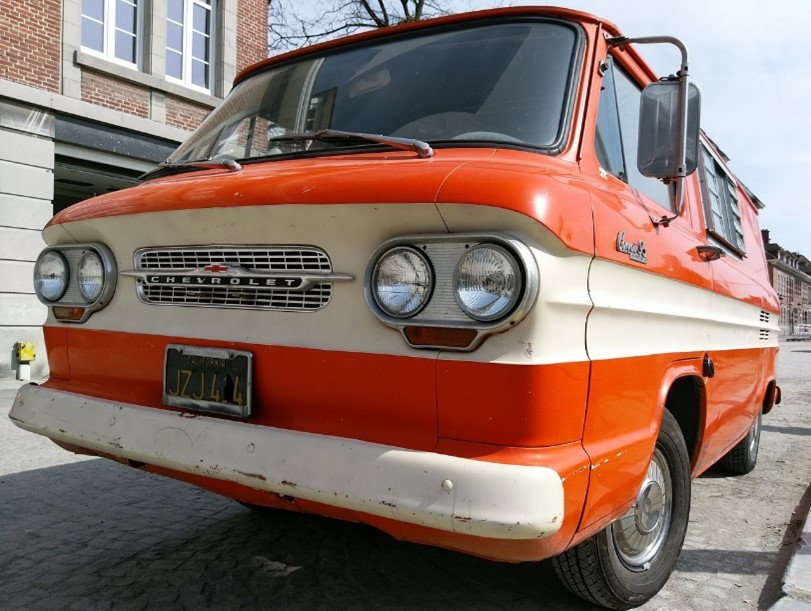If you are looking for the car of your dreams, or the motorbike from the poster you had on your wall when you were a teenager, then don’t think that you can only look locally. You don’t even need to be in the same country to purchase a vehicle and ship it to your door.
Take a leaf out of Martin’s book. He hankered for a Chevrolet G20 van, and when he found a 1978 model in the USA, he knew exactly who to contact to help import it to the UK for him – Autoshippers.
This article tells the story of Martin’s Chevrolet G20’s journey from the USA to the UK, and includes a step-by-step guide to importing, customs clearing and registering a vehicle from the USA to the UK.


Chevrolet Motor Company
The Chevrolet brand has been around for over a century, and was founded in the USA in 1911 by Swiss-born race car driver Louis Chevrolet and the founder of General Motors (GM) William C. Durant.
The first Chevrolet car model, the Series C Classic Six, was introduced in 1912. Priced at $2,150, it was a huge success and helped establish Chevrolet as a major player in the auto industry. In 1917, Chevrolet was acquired by General Motors, becoming their entry-level brand to compete with the Model T Ford. Under GM, Chevrolet continued to grow steadily.
Its vehicles evolved from the basic utilitarian cars of the 1910s to the tail-finned, chrome-laden designs of the 1950s and 60s. Models like the Bel Air and Corvette became cultural icons. Chevrolet introduced landmark vehicles like the small-block V8 engine in 1955 and the rear-engine air-cooled Corvair in 1960, showing its ability to innovate.
The brand has maintained its popularity globally by continuing to produce affordable, high-quality sedans, trucks and SUVs. The Suburban, Silverado, Tahoe and Corvette remain contemporary Chevrolet icons. Today, Chevrolet is GM’s top-selling brand and continues to have a strong cultural impact, representing classic American car heritage.
Chevrolet G20 Van


The Chevrolet G20 was a full-size van model produced from 1964 to 1996 over three generations, also known as the Chevrolet Sportvan, it was originally introduced in 1964 as a competitor to the Ford Econoline. The first generation ran from 1964-1970.
The second generation G20 was manufactured from 1971 to 1996, enjoying an exceptionally long 25-year production run with only minor updates along the way. It featured a lightweight body-on-frame construction and rear-wheel-drive powertrain layout, with an option for 4-wheel-drive later on.
Engine options consisted of GM-sourced V6 and V8 units, ranging from 4.1L to 7.4L displacement and 142-240 hp depending on the model year. Transmission choices included 3-speed automatic and 4-speed manual. The interior focused on functionality and durability, with vinyl bench seats, rubber mats and few comfort features. Cargo space was generous, designed for work or leisure.
Standard models could accommodate up to 15 passengers. Conversion vans with custom interiors were also popular. The G20 had a reputation for ruggedness and versatility. It was offered in multiple configurations including passenger van, cargo van and cutaway van chassis.
Major use cases included work vehicles, school/church buses, ambulance/emergency transports, camper vans and more. It remains a customisable American workhorse and an iconic US vehicle.
Shipping a Chevrolet G20 Van from the USA to the UK


Once you have found the vehicle that you want to bring to the UK, make contact with us at Autoshippers and we can arrange a quotation to let you know the cost of shipping. We can arrange collection from the seller in the USA using our specialist vehicle shipping agents, and arrange for the marine insurance coverage as well as the booking with the shipping line.
Martin decided on the RoRo (Roll on Roll off) option for his Chevrolet G20 Van, which is a specialist vehicle shipping service using vessels that enable cars, vans and other wheeled vehicles to be driven on and off, rather than loaded in shipping containers.
Although RoRo shipping can be more cost effective and quicker than container shipping, if you have a classic, vintage or high value vehicle to ship you may decide that you would prefer it to be loaded into its own dedicated shipping container. This reduces the amount of handling that the vehicle has on route, and means once loaded into the container it is not handled again until the container is unloaded at your chosen destination. This becomes more cost effective if you have more than one vehicle, because you may be able to utilise a 40 foot container rather than a 20 foot container, as you only pay for the container not the number of vehicles loaded.
Martin’s Chevrolet G20 needed to be collected from the seller in Roebuck using a vehicle transporter, and taken to the RoRo terminal at Charleston in the USA. Here it was loaded onto the vessel Donnington for shipping to the RoRo terminal at Southampton.
UK Customs Clearance of Vehicles from the USA
Once your vehicle has arrived and been offloaded from the vessel at the UK port, it will need to be cleared through UK Customs. Autoshippers can assist with this process and arrange the import Customs clearance on your behalf.
As part of the Customs Clearance process, VAT and import duty will need to paid (unless you are relocating permanently to the UK to returning after living abroad for more than 12 months as you may be eligible for relief on these costs)
To calculate VAT and import duty accurately, you’ll need to determine your vehicle’s customs value first. This includes factors like purchase price, shipping costs, insurance fees, and any additional charges related to transportation.
Once you have determined your customs value, calculating VAT is relatively straightforward. You’ll need to multiply your customs value by the applicable rate of VAT (currently 20% in most cases). This will give you an estimate of how much VAT you’ll have to pay upon import.
Calculating import duty can be a bit more complex, as it depends on several factors such as the vehicle’s engine size, CO2 emissions, and its age. The DVLA provides guidance and resources to help you determine the correct import duty rate for your specific car.
To calculate the total fees you’ll need to pay when importing a car into the UK, you’ll need to add VAT and import duty together. Once you have this figure, you can proceed with paying these fees to customs authorities.
When your vehicle arrives in the UK, it will go through customs clearance. At this stage, you’ll be required to provide relevant documentation such as purchase invoices, proof of ownership, and any other supporting paperwork.
After completing the necessary paperwork and paying the applicable fees, your imported car will be ready for registration with the DVLA. They will issue you a new UK registration number and provide all the information needed to ensure compliance with local regulations.
Sounds complicated? It isn’t, as Autoshippers will be there at all stages during the Customs Clearance process to ensure that you are able to have your vehicle released as quickly as possible and pay the correct costs to HMRC.
Registering an Imported Vehicle in the United Kingdom
Registering an imported vehicle in the United Kingdom (UK) is a crucial step for anyone looking to bring their car from another country. Not only is it a legal requirement, but it also ensures that your vehicle meets the necessary standards to be driven on UK roads. Without proper registration, you could face hefty fines and even have your car seized.
To successfully register your imported vehicle with the DVLA, you will need to gather the following documentation:
- Proof of ownership: This can be in the form of a foreign registration document or a bill of sale.
- Proof of insurance: You must have valid insurance coverage for your vehicle before it can be registered.
- Valid MOT certificate: Ensure that your car has passed an MOT test within the required timeframe.
- CoMR (if applicable): If your vehicle was manufactured within the EU, you will need to provide a Certificate of Mutual Recognition.
- Completed form V55/5: Fill out this form with accurate information about yourself and the vehicle.
- Proof of identity and address: Provide appropriate identification documents to verify who you are and where you live.
You will need to register your vehicle with the DVLA, by sending them the documents and paying any road tax that is applicable along with the registration fee which is currently £55.00
It can take up to 6 weeks for the V5C registration certificate to arrive, and you will need this to have the number plates made up and fitted.
Importing a Car with Autoshippers – The Car Shipping Experts
With over 25 years of experience and a solid reputation, Autoshippers are here to help you navigate the process of importing your dream car hassle-free. From handling all the necessary paperwork to ensuring the safe transportation of your vehicle, Autoshippers offers a seamless and reliable service tailored to your needs.
Contact Autoshippers today to get started on your car import journey. Our dedicated team of professionals is ready to assist you every step of the way. For inquiries or a free quote, reach out to us at +44 1234 567890 or send an email to info@autoshippers.com. You can also visit our website at www.autoshippers.com for more information on our services and reviews from satisfied customers. Trust Autoshippers to make your car import process smooth and stress-free.
With Autoshippers as your car shipping partner, you can rest assured that your vehicle will be handled with the utmost care and attention. Our team of experts understands the intricacies of international car shipping and will guide you through the necessary customs procedures, import duties, and regulations.
We offer a range of shipping options to suit your budget and timeline, including container shipping and roll-on/roll-off services. Contact Autoshippers today and let us take the worry out of importing your car, allowing you to enjoy the thrill of driving your dream vehicle on UK roads.
Summary – How to Import a Vehicle into the UK
For a complete guide on importing vehicles into the UK, the UK government website has all of the information that you would need.
In summary, certain steps need to be take as soon as you bring a vehicle into the UK permanently;
- Tell HM Revenue and Customs (HMRC) within 14days of the vehicle arriving into the UK.
- Pay VAT and Duty if HMRC advises you that this is required.
- Get vehicle approval to show that your vehicles meets the safety and environmental standards to be driven on UK roads.
- Register and tax the vehicle with DVLA, at this point they will issue you with a registration number so that number plates can be made up.
- Insure your vehicle before you drive it on UK roads.
There are different requirements for temporary imports and for bringing a vehicle back to the UK, so if these apply to you then check out the UK Government website for more details.
Car Import FAQs
Yes, you can import various types of cars into the UK as long as they meet certain criteria set by HMRC and DVLA. However, it’s important to note that some vehicles may be subject to additional restrictions or require modifications for compliance.
The cost of importing a car depends on several factors such as its value, age, emissions rating, and origin. Apart from the purchase price, you’ll need to consider VAT, duty fees, shipping costs, customs clearance charges, and other associated expenses.
When importing a car into the UK, it’s crucial to have appropriate insurance coverage throughout the process. Speak with your insurance provider about temporary coverage during transit and arrange comprehensive insurance once the vehicle is registered in the country.
Importing a car allows you access to a wider selection of models and specifications that may not be readily available in the local market. It can sometimes offer cost savings depending on factors such as exchange rates or tax differentials between countries.
Once your imported vehicle has cleared customs and is registered with DVLA, you are generally free to drive it on UK roads. However, ensure that all necessary paperwork is completed correctly before taking it out on public highways.
If a vehicle is fully taxed in its home country, it can be used on UK roads for up to 6 months. Please note however, that by law you must provide HMRC with the necessary vehicle information within 14 days of importing. Once the vehicle is registered with the DVLA it will be issued with a UK registration number and this should be displayed.
Remember that these FAQs provide general information but consulting experts in vehicle importation is highly recommended for personalised advice and accurate guidance. All details can be found on the DVLA website and a guide can be found here – https://assets.publishing.service.gov.uk/government/uploads/system/uploads/attachment_data/file/1183591/inf106-how-to-import-a-vehicle-into-the-united-kingdom.pdf












